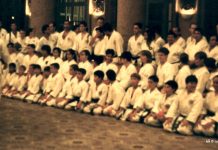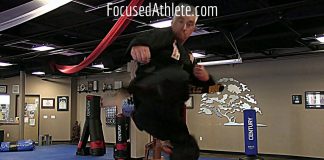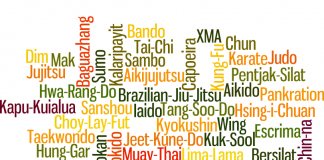I have had several jobs and careers as a physician, researcher, scientist, psychology professor, life coach, hypnotherapist, artist, and personal trainer. But first and foremost, I am a martial artist.
My last article about the amazing Dr. Bob was initiated because of our relationship through the martial arts. My most endearing, positive, productive, and enduring relationships have been established through the martial arts.
In January 2018, I will once again attend the Action Martial Arts Magazine Hall of Honors event in Atlantic City, New Jersey, hosted by Sifu Alan Goldberg the Founder and Editor of Action Martial Arts Magazine I was fortunate enough to have been inducted into this illustrious Hall of Fame several years ago and have attended the event every year since. It is the largest events of its kind in the world. Sifu Goldberg has gathered the Who’s Who in the Martial Arts world from self-defense instructors to fighting competitors, stylists, and world-famous actors/actresses like Don (“The Dragon”) Wilson, Cynthia (“Lady Dragon”) Rothrock, Bill “Superfoot” Wallace, Michael Jai White, John Pellegrini, Christine Bannon-Rodrigues, Cary-Hiroyuki Tagawa, Hank Garrett, Dr. Bob Goldman, Chuck Zito, James Wilson, Sasha Mitchell, Olando “The Warrior” Rivera, Dan (The Beast) Severn, Samuel Kwok, Michael DePasquale Jr., Maurice Elmalem, Benny “The Jet” Urquidez, Demetrius “OakTree” Edwards, Moti Horenstein, Mark Shuey, King Kong Bundy, Mark Goldman, Shonie (Mr. International) Carter, Ray Mercer, Stephen Hayes, Oso Tayari Casel, Gary Wasniewski, Kevin Bergquist, and Bob Backlund. There are dozens of seminars, competitions and the ability to hang out with and learn from the greatest martial arts superstars in the world!
Those with minimal exposure to martial arts may wonder why someone would care. Not only are these highly skilled athletes, these are some of the most well-rounded, successful and accomplished group of individuals that you will ever meet anywhere.
My Personal Experience with Martial Arts
At nine years old, I began to study martial arts. Bruce Lee was my hero. The physical challenges, the strength, flexibility, and excitement over being able to kick above my head and break boards with my hands was inspiring and motivating. I began in the Japanese arts of Judo, Aikido, Jiu Jitsu and Karate. At twelve years old I started learning Chinese Kung Fu and for my Bar Mitzvah present at 13, my parents signed me up for lessons in the Korean arts of Taekwondo and Hapkido. It became an addiction. Initially going three times a week, I gave up my Hebrew lessons, guitar lessons, and any free time I had, to the point of studying and practicing martial arts 4-5 hours per day, six days per week. It became my goal in life to be a martial arts instructor. As the years went by I continued to add new styles and techniques, such as Thai boxing and Israeli Self-Defense.
In university, I studied psychology as many of the concepts had been previously introduced through my martial arts practice. After medical school and residency, I was able to incorporate lessons learned from martial arts into my careers and integrated positive psychology into a wellness curriculum which I taught to physicians. I have found a tremendous overlap of martial arts with all other important aspects of my life. For example, as an anesthesiologist, I used the Chinese meridians that I learned in martial arts to apply acupuncture; treating various pain symptoms. I have taught martial arts from the time I was in high school throughout my career in medicine. Martial arts not only shaped who I am today, but has been the single most positively influencing factor in my life.
Many of us think of martial arts as something for kids to do as an after-school activity so they focus on discipline, respect, getting good grades, and have an outlet for their ADHD. True, martial arts can do those things. But it can be so much more if taken seriously and applied properly.
Kids attend classes and learn proper stances, punches, kicks, exercises, stretches and physical techniques. However, these lessons usually have deeper meanings which are important life lessons. When we learn about the importance of balance, the kids are practicing standing on one foot and doing a karate kid move, while I am deliberating on the power of achieving balance in my work and personal life, and balance in my need to give and take.
While there are certainly many benefits to participating in other sports and activities like soccer, gymnastics, and tennis, few can come close to the physical, psychological, emotional and spiritual health and wellness benefits that may be derived from serious martial arts practice. Below are some benefits of martial arts.
1) Responsibility: This is the first habit of Dr. Stephen Covey’s 7 Habits of Highly Effective People and one of the Keys to Achieve success in relationships, business and all aspects of goal-setting. We are each responsible for our thoughts, feelings, actions, inactions and responses. Without taking responsibility you are unable to truly experience positive growth and transformation to a better self.
Martial arts is a pathway to self-actualization. To not take responsibility is to put a wall in the path. We must be able to protect ourselves and those whom we love. We learn that if we don’t take responsibility we may lose the things most dear to us. With this knowledge, we become more aware of the words we use and our non-verbal communication when faced with conflict. We have control over how we respond to others and whether we choose to escalate or de-escalate conflict, whether we choose to avoid or evade a fight, and the extent of force that we use to end a conflict.
2) Discipline: Attaining and practicing self-discipline is a great asset in both our personal and professional lives. Regular practice of martial arts helps us gain the ability to control our emotions, desires and reactions. Martial arts teach us to think before acting, regulate our movements, and focus on action rather than reaction. The discipline involved in fine tuning and honing skills and techniques cannot be overstated. This ability becomes a way of life and permeates all aspects of our being.
3) Perseverance: People with perseverance are more likely able to accomplish long term goals in the face of adversity. Excelling in martial arts is extremely difficult – it takes thousands of hours of practice and dedication encountering many challenges along the way to developing new skill sets and advancing in belt ranks. Martial artists learn to view challenges as opportunities rather than obstacles; crucial in minimizing unhealthy dis-stress. As Aikido founder Morihei Ueshiba said, “Failure is the key to success; each mistake teaches us something.” It is this kind of attitude which leads to an enduring and striving spirit. Through challenges we may truly grow and by growing we may best face challenges. Martial arts emphasize that it is not how many times you fall down but the number of times that you get up that is the best predictor of success.
4) Values: Establishing goals based on your core values infuses them with deeper meaning and energizes you to pursue them passionately. Values set the course by which goals are established. Living a life based on your values is a foundation for achieving a balanced and satisfying life. Bringing life to your values will bring value to your life! Inherent in martial arts are a certain set of core values – respect for others, harmony, balance, spirituality, self-determination, self-protection, and service for others. These common belief systems help establish firm bonds between fellow martial artists and allow us to thrive in other non-martial art related activities throughout our lives.
5) Positivity: A focus on positivity and optimism is associated with many health and wellness benefits including less depression, less substance abuse, greater long-term happiness, better and more relationships, improved career success, improved immunity, and living a longer life. Martial arts instill many foundational principles of positive psychology such as a focus on personal strengths, flow, positive/productive communication, optimism, resilience and celebrating successes. The Hall of Honors event in Atlantic City, invites an enormous variety of styles, techniques and philosophies. We must each look within to get an honest and realistic assessment of our personal strengths and find the best martial art fit. When we are deeply engrossed in martial arts we find flow – the sense of purpose and timelessness like being in the zone. Marital artists must be able to find the glass half full as we turn challenges into opportunities. We celebrate our successes such as achieving higher belt levels, hall of fame inductions and community service awards, without being overly proud.
6) Humility: Society is embattled with the consequences of more ego, self-centeredness and entitlements. Being humble is associated with more effective leadership, more self-control, improved work and academic performance, less prejudicial behavior, more kindness and enhanced relationships. Martial arts help us appreciate our strengths yet be honest and objective about our limitations, weaknesses, and areas which need improvement. Even the most successful, most famous, and most accomplished martial artists are amazing examples of what it means to show humility.
7) Confidence: A lack of self-confidence has devastating consequences for children and adults leading to avoiding social interactions, inappropriate fears, poor relationships, poor job performance, depression, and substance abuse. With poor self-esteem, you are more likely to give up on goals in the face of adversity. Marital arts excel at promoting self-confidence and self-esteem in its practitioners. By teaching respect for others, including your opponents while instilling the importance of individual responsibility, martial arts promotes balance between humility and confidence. There are endless opportunities for achieving goals and developing self-confidence.
8) Respect: Having respect for others improves all of your relationships. Respect begets respect. Showing respect and appreciation of others encourages them to respect you and increases the likelihood of having others be kind to you. Respect includes friends, foes, and strangers. Employees report that the single most important trait that a leader can possess is that of respect for their workers. In martial arts not only do we respect our teachers, mentors and those wearing a higher belt, but we also learn quickly to respect our opponents. This trait is important to not get cocky and make dangerous assumptions about their abilities.
9) Goal Setting: Setting goals provides direction in life, helps clarify your personal mission and decision-making. It gives you a defined focus on what is truly important and allows more control of your future journey; helping you anticipate and prepare for future challenges. Setting goals is motivating and inspiring. As described in my domino theory of goal-setting, there are many dominos on the road to becoming an accomplished martial artist. Your goal may involve earning a higher level belt, achieving a black belt, beating your personal best for number of strength exercises or stretching further than you’ve ever stretched before. The number and variety of goals are endless and the drive, motivation and sense of accomplishment achieved in martial arts is awe-inspiring and can easily be applied to all other aspects of your life.
10) Flexibility: Maintaining physical flexibility is important for many reasons including increased blood circulation and energy levels. Greater muscular coordination, less muscle tension and increased range of movement decreases the chance of injury and back pain. Similarly, being flexible in your thinking reduces the chance of psychological injury in the form of stress, depression, and anger. Martial arts teach us to be strong yet flexible. Set goals yet be amenable to altering your path based on new circumstances and information. Embracing change is necessary for success in the workplace. With the advent of new technologies and changing markets, flexibility drives innovation and creates boundless opportunities. In relationships at home, at work, at school, or at play, we must remain flexible and embrace the dynamics of any situation to fully appreciate and benefit from the new consequences which are inevitable. This we learn through martial arts practice.
11) Balance: Balance training improves joint mobility, decreases injuries and falls, improves control over and awareness of one’s body position, enhances overall sport performance, reaction time, strength, power and agility and even enhance cognitivememory abilities. We strive for balance in work and personal life, daily schedules, or psychological balance; not being too bored or too overstimulated, not too carefree or too uptight, not too stingy or too spendthrift, not too trusting or too suspicious, not too daredevil or too fearful, not too cautious or too outgoing, not too introvert or too extrovert. We may become off balance as we strive toward a single focused goal. The ability to recognize this and make necessary adjustments are important. Marital arts focus on the physical aspects of gbalance training but also the mental, psychological and spiritual aspects. If you are physically too focused on pushing forward, one has but to deflect your energy and step sideways to help you lose your balance. Similarly, if you are mentally too focused on pushing forward in an argument, you may not be open to new information, lose respect and injure your status in a relationship.
12) Work ethic: Success takes work; physical work, mental work, preparedness, and often spiritual work. True achievement takes fortitude, action and sweat. Martial arts training forms the foundational base for establishing a healthy work ethic. You could go online and buy a black belt but the initial satisfaction of seeing it hanging on your wall would quickly fade when the realization sets in that this was not earned. I attribute the work ethic I learned through martial arts to my successes in the medical and academic world. Not being satisfied with getting by, we strive for excellence. As Bruce Lee said, “I fear not the man who has practiced 10,000 kicks once, but I fear the man who has practiced one kick 10,000 times.” The more you sweat in training, the less you bleed in combat.” Richard Marcinko.
13) Wisdom: We tend to lump all martial arts styles under the umbrella “martial arts.” Martial arts reflect the people, culture, weapons, and specific circumstances of their countries of origin. These differences are reflected in how they emphasize stances, kicks, punches, blocks, and body movements. Becoming an accomplished martial artist requires more than simply learning the physical techniques. One must understand the history, culture, people, and even the language. Mastering a specific martial art necessitates practicing enough to incorporate techniques into muscle memory as well as a deeper understanding about proper body mechanics, kinesthesiology, anatomy and physiology, situational awareness, conflict management, de-escalation techniques and possibly weaponry including materials and manufacturing technology. I have been fortunate in being able to apply knowledge gained through martial arts in my travels to the far east and in building positive productive relationships with people from a variety of cultures. A quote often attributed to Bruce Lee is “Before I learned the art a punch was just a punch and a kick just a kick. After I learned the art, a punch was no longer a punch and a kick no longer a kick. Now that I understand the art, a punch is just a punch and a kick just a kick.” This is the mastery effect; associated with high self-efficacy and enhanced performance.
14) Courage: Acting appropriately in the face of adversity without overconfidence or inappropriate fear. Courage is important for those with families and friends whom they care to protect. It enforces personal boundaries, enhances self-confidence and has the ability to strengthen teamwork. Courage is a trait strongly nurtured by martial arts practice. Even for those with a predilection to be guided by fear, visualizing and undergoing repetitive, stressful, realistic self-defense drills helps one develop the necessary courage to face fears – both physical and psychologic. We learn martial arts not so we can hurt those in front of us but to protect those whom we love standing behind us.
15) Creativity: Creativity relieves stress and promotes overall health and wellness. It improves mood and overall emotional health, enhances brain function, promotes the production of new neurons, and may even help prevent Alzheimer’s. True practice of martial arts goes well beyond planned patterns. Only following such patterns is to take away one’s freedom and falsely lead to the belief that the pattern accurately represents reality. Martial arts promote creativity in one’s approach to novel situations; thinking out of the box and using a dynamic approach to apply and develop new techniques or use old techniques in new ways. This is why so many martial artists exemplify the term “artist”. They are actors, painters, sculptors, dancers, and musicians who are able to apply this creative code to other aspects of life.
16) Leadership: Leaders set direction, create visions, inspire and motivate others, forge teams and create productive organizations. Leadership involves valuing and respecting others and knowing their strengths, thinking out of the box, looking at obstacles as opportunities and taking responsibility for their decisions. Martial arts encourage a leadership frame of mind – a mindset of improving our community and improving the world. It starts with a dream about what could be, visualizing how this will be and taking action to make it happen. Implicit in this framework is the self-confidence, responsibility and belief that one can make a positive difference. The emphasis in martial arts on effective communication, respect for allies and foes, presenting a respectable appearance, striving for self-improvement, showing humility and taking action fosters effective leadership qualities.
17) Open-Mindedness: Being open-minded is only possible if you assume that you don’t have all of the information. This is an essential trait for success in relationships, in business, and in acquiring or advancing in any sport, hobby, or activity. This can be difficult when the new information counters our long-held beliefs. However, the payoff is well worth it as we gain valuable new knowledge, become stronger, more confident and learn to change our mistakes into life lessons for success. The martial arts master pours tea into an already full cup and the tea overflows onto the table and floor. The student says, “what the heck?” The master says, “Like this cup you are so full of ideas that you can’t hold onto anything new. You must first empty your cup to be able to gain new knowledge.” As one of my instructors, Avi Nardia often states, “Sometimes a teacher, always a student.” An effective martial arts practice is dynamic wherein the martial artist must be open to new information to adequately respond with appropriate counters.
18) Mindfulness: An open, non-judgmental moment-by-moment awareness of your thoughts, feelings, bodily sensations and surrounding environment. A focus on the future is to live in a dream and a focus on the past is to live in a memory. Mindfulness is a focus on the here and now. It is associated with improved health and wellness, lower stress, better decision-making, less errors, an improved immune system, better relationships and greater life satisfaction! It gives us a greater sense of mental clarity and focus. Mindfulness is a key ingredient of martial arts practice. More than just being aware of what is going on; there is an implicit deeper sense of spiritual contemplation and reflection. As Harvard Psychology Professor Ellen Langer has described, mindfulness is the process of actively noticing new things, relinquishing preconceived mindsets and acting on the new observations. As in Buddhism, where mindfulness originated, martial arts helps us focus on our breath to anchor our thoughts. To excel in martial arts one must commit to being fully present in the now. Distractions of past recollections or future predictions may be life threatening.
19) Situational Awareness: Being alert to what is happening around you and understanding how certain situations, physical objects, events, and actions may affect outcomes. Situational awareness involves having a level of emotional and social intelligence to perceive and adequately interpret non-verbal information. A lack of this awareness is a primary contributor to accidents caused by human error. In martial arts it is necessary to be able to incorporate this information analytically with other input to fully assess your situation and avoid placing yourself in dangerous predicaments. The concept of situational awareness can be traced back to Sun Tzu’s The Art of War from the 5th Century BC. Bruce Lee called this “the art of fighting without fighting.” The art of verbal de-escalation, anticipation, and appropriate avoidance; the way of the peaceful warrior. We learn to fight so that we don’t have to.
20) Action: Action separates dreaming from doing; taking an active role in your destiny is one of the keys to success, not leaving your future to the universe and hoping things get better. Action arising out of your principles, energized by visualizing your goals and the path to getting there will be deep-seated, meaningful and inspired. Thinking about changing the world in a positive way is good, talking about it is great, doing it is best! Martial arts is not just a way of being, it is a way of doing. We learn to control our bodily movements with precision as we gain an understanding of how minute movements may have tremendous consequences such as during pressure point application or joint manipulations. We appreciate that in all aspects of life we have a personal responsibility to take inspired action. A Japanese Proverb says, “In the struggle between the stone and water, in time, the water wins.” The stone may seem stronger but it just sits there as the water takes action.
I am hugely and eternally grateful of the opportunities afforded me by virtue of my involvement in the martial arts world. The positive psychology lessons, the health and wellness benefits and the powerful influences of being able to interact with amazing individuals who embody the true spirit of what it means to be a martial artist.
I highly encourage everyone to check out some of their local martial arts schools and begin your martial arts education with a visit to one of the greatest martial arts events in the country at the Action Magazine Hall of Honors January 26-28.
Important note: On full disclosure, I receive no benefits, monetary or otherwise for anything related to the Hall of Honors event. I do not own or work for this organization. I am merely an admirer and supporter.







